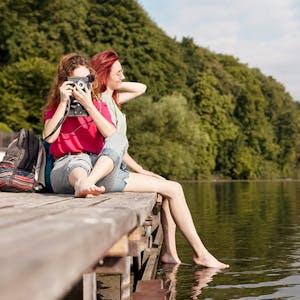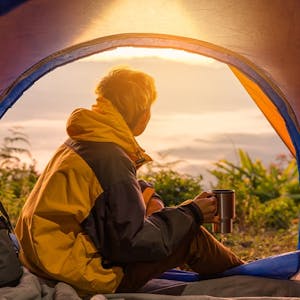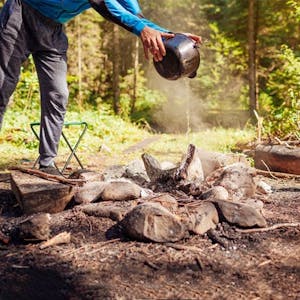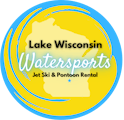LAKE WISCONSIN CAMPING

Top Tips for Choosing Your Lake Wisconsin Campground
The ultimate guide to a camping paradise
Welcome, fellow camping enthusiasts! If you’re planning a vacation near Lake Wisconsin, you’ve come to the right place. With its stunning natural beauty, wide range of attractions and activities, and a variety of campgrounds to choose from, there’s no better destination for an unforgettable outdoor experience. But with so many options, how do you pick the perfect Lake Wisconsin campground for your needs?
Worry not, as this ultimate guide is here to help you navigate through the different types of campgrounds, amenities, activities, and essential tips to make your Lake Wisconsin camping trip a memorable one. We’ll explore everything from basic campsites to luxurious glamping spots, and we’ll dive into the factors to consider when selecting the perfect campsite for your vacation.
So, get ready to learn all you need to know about camping on Lake Wisconsin and embark on an incredible adventure tailored just for you. Let’s dive in!

Exploring the wide variety of campgrounds around Lake Wisconsin
Ready to dive into the wonderful world of Lake Wisconsin campgrounds? Well, buckle up because we’re about to explore the many options you’ve got when it comes to camping in this beautiful area. From basic sites to glamping experiences, there’s something for everyone!
First off, let’s chat about the types of campgrounds available. There are basic campgrounds that offer just the essentials like a picnic table and a fire pit, or even literally just a place to pitch a tent. Then there’s everything up to full-amenity campgrounds, which provide more comforts like restrooms, showers, and even Wi-Fi. And if you’re pitching a tent with your family, don’t worry — family camping options abound, with playgrounds and other fun activities for the kiddos. Speaking of family, we can’t forget our furry friends! Pet-friendly camping is quite popular in Lake Wisconsin, so feel free to bring along your well-behaved four-legged pals. Just be sure to check the specific rules and guidelines of each campground, as some may have restrictions.
Now, it’s up to you to decide what level of convenience you’re after, but keep in mind that more amenities usually means a higher price tag.
Now, if you’re an RV enthusiast, you’ll be thrilled to know that many Lake Wisconsin campgrounds also cater to your needs. With spacious sites and hookups for water, electricity, and sewer, you’ll feel right at home on the road.
With all that in mind, let’s look at some of the differences between the types of camping ground, so you can start narrowing down your choices.

Public vs. private
Public campgrounds, typically managed by state or federal agencies, offer a more affordable camping experience and often showcase stunning natural surroundings. Private campgrounds, on the other hand, might have extra perks like swimming pools, game rooms, or even on-site restaurants.
Front country vs. backcountry
Front country camping grounds are all about easy access and convenience, with drive-up campsites and facilities nearby. Backcountry campgrounds, however, require a bit more effort – you’ll usually need to hike or backpack to reach these more secluded spots. The trade-off? A more peaceful escape and a deeper connection to nature.
Glampgrounds
Glamping, the glamorous cousin of traditional camping, might be an option if you’re looking for a little more luxury. And Lake Wisconsin has some fantastic glamping options. It’s the perfect way to enjoy the great outdoors without sacrificing comfort. For example, Shoreline Tours & Camping offers a hassle-free experience with services like campsite setup and teardown, and even shuttle buses.
So many camping styles, so little time!
We’ve already discussed the types of campgrounds available, but let’s delve a little deeper into the different camping styles you can choose from when exploring Lake Wisconsin. These include car camping, RV or trailer camping, backpacking, kayak or canoe camping, winter camping, survivalist camping, and, of course, glamping. Depending on your preferences, you can pick from any of these to make the most of your trip.

Car camping
Car camping is perfect for beginners or families with young children and pets, as it offers easy access to facilities and amenities.
RV and trailer camping
RV or trailer camping, on the other hand, allows you to drive long distances and visit different campgrounds, but may not offer the same remote, immersive experience as other types.
Backpacking
If you’re seeking a more challenging experience, backpacking might be the way to go. This versatile option allows you to explore remote areas and get closer to nature, as long as you’re in good physical condition.
Kayak or canoe camping
Canoe and kayak camping allow you to explore areas only accessible by water and offer a unique perspective on our region. We offer kayak rentals for up to six days, which is perfect if you’re keen to go kayak camping.
Winter camping
Winter camping is a peaceful and private way to enjoy the snow-covered landscapes around Lake Wisconsin. Just make sure you have the right gear and experience to stay warm and safe.
Survivalist camping
For the truly adventurous, survivalist camping is an extreme and primitive option that will test your skills and mental fortitude, but it’s not recommended for beginners or those without the right knowledge and experience.
Glamping
For a more luxurious camping experience, glamping is a fantastic choice. With upscale amenities like heated tents, hot showers, and gourmet meals, you can enjoy the great outdoors without sacrificing comfort. As we mentioned above, companies like Shoreline Tours & Camping offer hassle-free glamping experiences, including campsite setup, teardown, and shuttle buses.
Discover the amazing amenities and activities on offer at the various camping sites in Lake Wisconsin
From fun family-friendly facilities to outdoor adventures for solo travelers, there’s something for everyone at Lake Wisconsin campgrounds. And you can expect a range of amenities depending on the type of site you choose.
Fun for families
Traveling with kids? Camping sites around Lake Wisconsin offer some really amazing activities and amenities for all kinds of families.
For example, Smokey Hollow Campground offers nail painting, along with face painting for younger kids and airbrushed temporary tattoos for teens and teenagers. The jumping pillows at Smokey Hollow, Merry Mac’s, and Skillet Creek campgrounds are also super popular with toddlers, preschoolers, and elementary-school-aged kids. All those campgrounds have playgrounds as do Sky High Camping Resort and Devil’s Lake State Park Quartzite and Northern Lights campgrounds.
Lots of families with kids of all ages enjoy the mini golf on offer at Smokey Hollow, Sky High, and Merry Mac’s. Many of the campgrounds also have swimming pools or swim zones. Sky High Camping Resort also has a wading pool. And Devil’s Lake State Park boasts an impressive 500-foot-long sandy beach, perfect for soaking up the sun or taking a refreshing swim.
If your family is into sports, Smokey Hollow Campground, Sky High Camping Resort, and Skillet Creek Campground have sporting courts, such as volleyball, basketball, and bocce. Or if you’re more interested in quieter outdoor activities, Smokey Hollow and Merry Mac’s have giant game sets like chess and checkers. Many of the campgrounds also have indoor games rooms.
Be nurtured by nature
If you’re after some privacy, you’ll be glad to know that campgrounds like Merry Mac’s Campground offer more secluded sites, letting you unwind in peace. And Skillet Creek Campground offers a more primitive camping experience, with rustic campsites surrounded by stunning natural beauty.

Enjoy the water
For those who love water activities, many campgrounds on the shores of the lake provide boat access, allowing you to explore the beautiful Lake Wisconsin with ease. Some, like Crystal Lake Campground, even feature water trampolines and inflatable obstacle courses for some exciting fun on the water.
Get out and about
When it comes to location, many campgrounds are situated near popular attractions, making it convenient for you to explore the area. For example, all the Devil’s Lake campgrounds are close to beautiful natural attractions.
Lake Wisconsin and its surrounding campgrounds also offer countless opportunities for outdoor adventures like hiking, fishing, and wildlife watching.

How to select the perfect campground when lake camping near Lake Wisconsin
Hey, fellow campers! So far we’ve outlined the types of campgrounds on offer and highlighted some of the key amenities you might be interested in. But what else could play into your decision about which campground to choose? And how do you bring all that information together to make a great choice? Don’t worry, we’re here to help with that too.
1. Consider special features
Before deciding anything else, we suggest you make a list of any special features your campground absolutely must have.
As an example, are you bringing your furry friends along? If so, you’ll need to ensure the campgrounds you’re considering are pet-friendly campgrounds, so your beloved pets can enjoy the great outdoors with you. Many campgrounds in Lake Wisconsin welcome pets, but it’s always best to check their policies before booking. Here are some of the most popular campgrounds, which are pet-friendly:
- Double K-D Ranch
- Devil’s Lake State Park – Quartzite Campground
- Devil’s Lake State Park – Northern Lights Campground
- Devil’s Lake State Park – Ice Age Campground
- Skillet Creek Campground
- Buddy’s River Resort (formerly Snuffy’s Campground)
- Smokey Hollow Campground
- Merry Mac’s Campground
- Crystal Lake RV Resort & Campground
- Sky High Camping Resort
Another key thing that may be a necessity for you, or someone in your group, is accessibility. For example, if you need wheelchair-accessible toilets, it’s best to exclude campgrounds that aren’t suitable early on. We strongly recommend contacting campgrounds directly to discuss your specific needs as what’s appropriate for one person may not be suitable for another.
2. Then wishlist the amenities
Next, we suggest you think about the amenities you desire. For example, if you’re all about comfort, you might want to opt for a full-amenity campground like Crystal Lake Campground with fun activities and facilities like water trampolines. If you prefer a more rustic experience, a more basic campground like Skillet Creek Campground or one of the Devil’s Lake State Park campgrounds might be more your speed. And if you’re planning on taking a long vacation in the area, you might really appreciate the on-site laundry facilities at places like Crystal Lake RV Resort & Campground, Skillet Creek Campground, and Buddy’s River Resort. Also, some campgrounds have Wi-Fi, and that might be a pro or a con depending on your goals for your trip!
3. Consider privacy and noise levels
If you’re keen to mingle with other vacationers as much as possible, you might want to opt for a campground that has lots of sites spaced close together. If privacy is more your priority, you might prefer a campground with spacious, well-separated campsites, a lower total number of sites, and wooded or natural surrounds that can act as a barrier between sites. If you’re looking for a more secluded experience, consider campgrounds, like Merry Mac’s Campground, that offer private sites. Keep in mind, though, that these sites might be a bit farther from popular attractions.
To some extent, noise levels go hand-in-hand with privacy leaves. If there are fewer campsites spaced further apart or separated by natural ‘barriers’, things are likely to be quieter. Some campgrounds also have enforced quiet hours, which can help ensure a restful sleep if you’re a light sleeper. However, it’s also worth considering the location of the actual campground as well. Some are situated close to lots of car traffic, which is likely to increase noise levels regardless of how the sites are laid out.
But again, campgrounds near major roads generally offer easier access to nearby attractions.
4. Shortlist the attractions you’re interested in
Speaking of attractions, if you’ve still got several campgrounds on your list, you may like to make the final decision based on how close your options are to the activities and sights you’re excited to explore. Many Lake Wisconsin campgrounds are conveniently located near hiking trails, fishing spots, and other attractions to make your stay even more enjoyable. But some are closer to specific attractions.
For example, if you’re keen to check out the Gibraltar Rock State Natural Area, Crystal Lake Campground is the closest campground. And if you know you want to explore the Devil’s Lake State Park, all the campgrounds within the State Park are going to give you ready access. The Devil’s Lake campgrounds are also only a quick drive from Baraboo attractions like the Circus World Museum, Pewit’s Nest Gorge, Driftless Glen Distillery, and the Balanced Rock and Von Klaus wineries.
5. Consider your season of travel
As a final tip, don’t forget to consider seasonal factors. Some campgrounds get particularly busy when the weather is warm and thus perfect for water sports and other outdoor activities. Something like the Sky High Camping Resort, on the other hand, can be very popular in the middle of winter due to its close proximity to Cascade Mountain’s ski and snowboard runs. So, booking well in advance of your trip might be necessary for some campgrounds if you’re planning your trip for a peak season.
The time of year you take your vacation may also heavily impact how much you enjoy your visit. If you’re keen to mingle with lots of holidaymakers, you might prefer to book during peak season. On the other hand, choosing a less crowded time to visit could help you have a more enjoyable experience.
Important safety tips and rules for Lake Wisconsin camping
While we all want to have a fantastic time during our Lake Wisconsin camping adventures, it’s essential to stay safe and follow the rules, so everyone can enjoy their trip. And that applies no matter which campground you end up booking. So, let’s dive into some safety tips and regulations you should be aware of when camping in Lake Wisconsin.

Making and breaking camp
First off, always make sure to set up camp in designated camping areas. These spots are chosen for your safety and to minimize the impact on the environment. Plus, it helps keep the area beautiful for future visitors.
While we’re on the subject, when you’re setting up your tent or RV, we strongly recommend you do so before it gets dark. Firstly, it’s kinder to those around you as setting up camp can be noisy. But it’s also kinder to you. There’s nothing like pitching a tent in the dark and accidentally setting it up over the top of a tree root or something else that’s going to be uncomfortable to sleep on.
By the same token, try to avoid setting off too early. Breaking camp can be noisy too.
Note, some campgrounds will require you to make and break camp between certain times, so always check your campground’s rules.
Fire safety
Campfire safety is crucial when camping. Build your campfires in designated fire rings, pits or grills, keep them a manageable size, and never leave them unattended. When it’s time to call it a night, douse the fire with water until it’s completely out. Remember, only you can prevent forest fires!
Always watch children around fires and keep an eye on the weather conditions. Many people have been seriously injured by a fire that’s flared suddenly due to wind, and a hospital trip and skin grafts is not the way you want to end your camping trip!
An alternative to a campfire would be to bring a portable cooker.
While we’re on the subject of campfires, some campgrounds, especially those in state forests, have restrictions around where you can collect firewood. So, be sure to check those rules too.
The other thing to be aware of is rules around fireworks. Most fireworks in Wisconsin are illegal without a permit. Sparklers and ‘snakes’ are ok but not much else. However, even if you have a permit, you may not be allowed to set off fireworks within your campground. This is especially true of Devil’s Lake State Park where fireworks could cause a wildfire. So always be sure to check your campground’s rules around fireworks.
Wildlife
While much of the wildlife you’re likely to see while camping near Lake Wisconsin will be harmless or mostly harmless, there are some animals and insects to be wary of.
Two of Wisconsin’s snake species are venomous — the timber rattlesnake (Crotalus horridus), which is aggressive and tends to hang out in rocky areas, and the swamp rattlesnake or massasauga (Sistrurus catenatus), which, as its name suggests, tends to hang out in marshy or swampy areas and is endangered so rarely seen. The timber rattlesnake is usually found in southwestern Wisconsin and the massasauga is usually found in west-central Wisconsin. You might see either snake near Lake Wisconsin, but an encounter isn’t super likely.
Some animals that aren’t deadly but which can cause problems include bats, skunks, and porcupines. Bats can carry rabies and some other illnesses that can be transmitted to humans, so it’s best to enjoy them from afar. Skunks are another animal to view from afar. Smelling like skunk or getting skunk oil in your eyes is probably not your idea of a fun vacation or weekend away! A run-in with a porcupine can lead to a world of pain thanks to their barbed spines. Dogs are probably more likely to have trouble with porcupines.
Speaking of pets, coyotes and wolves may attack even large dogs, so keep your pets close. Bears can also injure or kill pets and humans for that matter, but attacks are rare. They’re more often a nuisance when they get into your food supplies, so be sure to keep your campsite clean and store your food properly.
You’ll notice several biting and stinging insects in the area. Being stung or bitten can be painful but it’s only dangerous for people who suffer allergic reactions. If you’re allergic to any kind of insect sting or bite, always carry an epipen in a place that’s easy to get to. An emergency medical kit is also a good idea for everyone regardless. Make sure it’s got tweezers in it in case of tick bites and bandages in case of snakebite. Experts recommend doing a full-body check for tick bites each day to help prevent Lyme disease as it takes 24h or more of feeding from a deer tick to transmit Lyme disease.
While they’re not wildlife, some plants can also pose a threat to pets and humans. Several species of hemlock and nightshade can be found in the area. They’re poisonous and so are dangerous if accidentally eaten. Poison ivy, sumac, wild parsnip, and stinging nettles can cause severe skin reactions. And for hay fever and asthma sufferers, ragweed pollen is common in August and September.
For more information about these potential hazards, check out ‘Outdoor Hazards in Wisconsin’.
Campground etiquette and unwritten rules
In addition to setting up and breaking camp at reasonable hours, there are a few other things you can do to play nice with your fellow campers.
Abide by the noise regulations at your campground. Most campgrounds have quiet hours, usually between 10 pm and 7 am. Be respectful of your neighbors and keep noise levels down during these hours.
If you’re camping with pets, make sure to follow the campground’s pet rules. Keep your furry friends on a leash and never leave them unattended. Also, always clean up after them to maintain a pleasant environment for everyone.
Don’t take shortcuts through other people’s campsites. It’s best to stay on well-worn paths.
Leave no trace
Don’t forget about the Leave No Trace principles! They help minimize our impact on the environment and keep the area pristine for future generations. Dispose of waste properly, leave what you find, and respect wildlife and fellow campers.
Get ready to embark on your Lake Wisconsin camping adventure
And there you have it, fellow outdoor enthusiasts! You’re now armed with all the essential info for planning an unforgettable camping trip on Lake Wisconsin. From exploring the variety of campgrounds available to finding the perfect spot that fits your needs, you’re all set for a fantastic adventure.
Remember, Lake Wisconsin offers incredible campgrounds, each with its unique amenities and activities for families, couples, and solo travelers. Whether you’re into basic camping or glamping, there’s something for everyone. And, now you’re well-informed about safety tips and campground rules, you can confidently navigate your way through the diverse camping experiences Lake Wisconsin has to offer.
So, what are you waiting for?
It’s time to pack your bags, gather your loved ones, and embark on your Lake Wisconsin camping adventure. Get ready to create lasting memories, explore the great outdoors, and enjoy all the beauty and fun that camping on Lake Wisconsin has to offer. Happy camping!
Essential resources for planning your unforgettable Lake Wisconsin camping trip
As you prepare for your lake camping adventure in Lake Wisconsin, it’s always good to have some handy resources at your fingertips. These tools can help you find the perfect campground, plan activities, and make the most of your vacation. Here’s a list of useful resources to help you plan the ultimate Lake Wisconsin camping experience:
- Campground reservation websites — Reserve your spot in advance to ensure you get the perfect campsite. Check out websites like ReserveAmerica or Recreation.gov for booking and availability information.
- Local tourism websites — The official Lake Wisconsin tourism website is a treasure trove of information on activities, events, and attractions in the area. Make sure to explore their site to find hidden gems and exciting activities to fill your itinerary.
- Maps — Don’t forget to have a good map, whether it’s a physical copy or a digital version on your smartphone. Maps will help you navigate the area, find trails, and locate nearby points of interest.
- Guides to Nearby Attractions — Lake Wisconsin is surrounded by incredible attractions like Devil’s Lake State Park, hiking and biking trails, and charming towns. Research these attractions ahead of time and create a must-see list for your trip.
With these essential resources, you’re now equipped to plan a memorable and hassle-free lake camping trip in Lake Wisconsin. Happy exploring!
